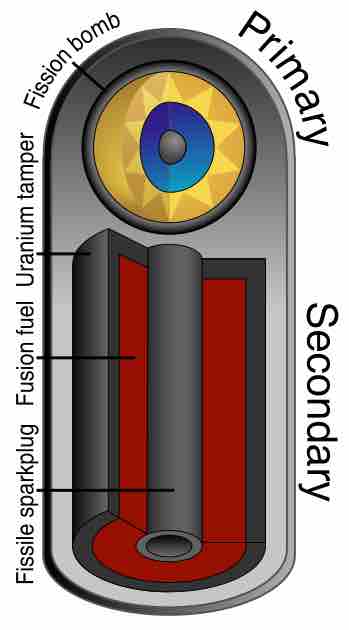Thermonuclear Weapons
A thermonuclear weapon is a nuclear weapon designed to use the heat generated by a fission bomb to compress a nuclear fusion stage. This indirectly results in a greatly increased energy yield, i.e., the bomb's "power." This type of weapon is referred to as a hydrogen bomb, or H-bomb, because it employs hydrogen fusion. Oddly, in most applications, the majority of its destructive energy comes from uranium fission, not hydrogen fusion alone. The fusion stage in these types of weapons is required in order to efficiently create the large quantities of fission that are characteristic of most thermonuclear weapons.
Features of a Hydrogen Bomb
The essential features of a mature, thermonuclear weapon design, which officially remained secret for nearly three decades, are the following:
- First, the stages of the weapon are separated into a triggering, primary explosive and a much more powerful secondary explosive.
- After this, the secondary explosive is compressed by X-rays coming from the nuclear fission of the primary explosive. This process is called the "radiation implosion" of the secondary explosive.
- Finally, the secondary explosive is heated, after cold compression, by a second fission explosion that occurs inside the secondary explosive.
The most common bomb design that employs these features is called the Teller-Ulam configuration. It should be noted that no hydrogen bomb has ever been used during the course of an actual war. The only two nuclear weapons that have been used were both fission-based.

Teller-Ulam device, a fusion nuclear bomb
The basics of the Teller–Ulam design for a thermonuclear weapon. Radiation from a primary fission bomb compresses a secondary section containing both fission and fusion fuel. The compressed secondary is heated from within by a second fission explosion.
The most important principle of the Teller–Ulam configuration is the idea that different parts of a thermonuclear weapon can be chained together in "stages," in which the detonation of each stage provides the energy necessary to ignite the next stage. At a bare minimum, this includes a primary section, which consists of a fission bomb (a "trigger") and a secondary section which consists of fusion fuel. The energy released by the primary section compresses the secondary through a process called "radiation implosion," at which point it is heated and undergoes nuclear fusion.
The nuclear fusion releases neutrons much faster than a fission reaction, and these neutrons then bombard the remaining fissile fuel, causing it to undergo fission much more rapidly. As such, the main explosive force for the explosion still arises from a fission reaction, but the neutron source for it arises from fusion.
Due to the staged design, it is thought that a tertiary section, again comprised of fusion fuel, could be added after the first two stages, based on the same principle that governs the secondary. A different design, the AN602 "Tsar Bomba," is thought to have been a three-stage device.